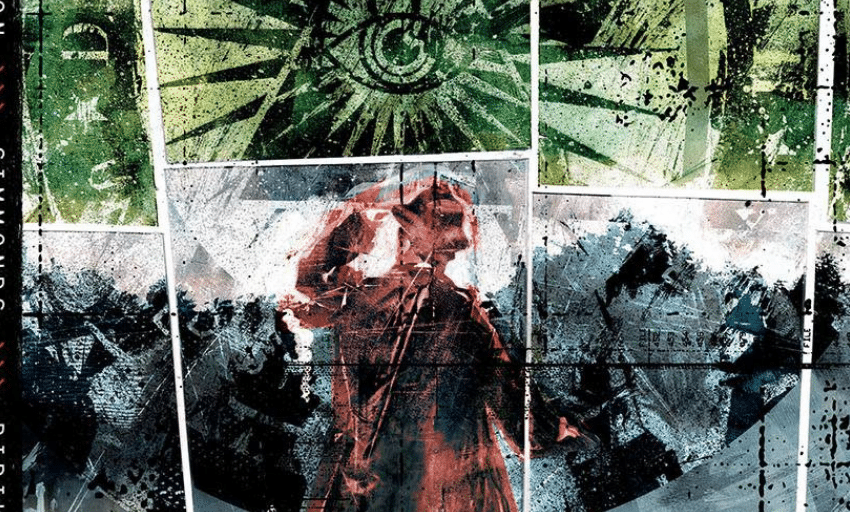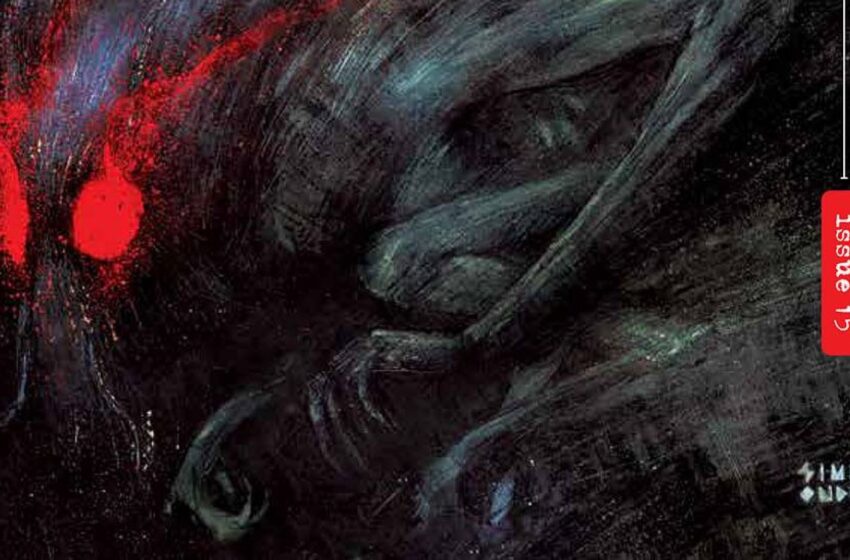It’s the second of two “deviations,” detours with guest artists that shine the light of inquiry into the darker corners of the universe created by writer James Tynion IV and artist Martin Simmonds. Are you prepared for Department of Truth #7 by Tynion, artist Tyler Boss, colorist Roman Titov, letterer Aditya Bidikar, designer Dylan Todd and editor Steve Foxe?
Will Nevin: If there’s any doubting the durability or flexibility of Department of Truth’s “conspiracy theory of the month” format, I’d point to issues #6 and #7 — the former takes up an arcane plot within the Catholic Church to tinker with our calendar, and the latter — this month’s issue — is all about the “Men in Black” and UFOs, which is probably the second-most ubiquitous conspiracy/evidence-free belief after the Kennedy assassination. Forrest, Tynion and Co. aren’t afraid to take up anything in this book, and they will do it in any damn order they please.
Forrest Hollingsworth: I totally agree the biggest success Department has had thus far is in how expansive, multifarious and representative it feels — the way every issue has the potential to really grab an individual reader. I, for example, was fortunately in the right headspace for the issue about Sandy Hook that I know many struggled with, but was really, adversely and fascinatingly struck by this one because I have struggled throughout my life with sleep paralysis that almost always presents itself as being horrifically abducted by aliens. Not normally fun, not normally something I want to talk about, and I actively had to ready myself and take breaks to read this issue, but it sure was worth it!
The Boss Man is In

WN: Let’s start with guest artist Tyler Boss. Just like last month, this is about the farthest thing from a cheap fill-in we could have; everything here feels organic without being too different from the main series, and Boss pulls off Doc’s ’zine with some goddamn panache.
FH: Boss does a great job of pulling a lot of disparate alien imagery into the more singular mythology here. The tin foil hat, the atom and UFO silhouette callouts in the diner scene evoking the cut-and-paste nature of the ’zine in hand, the sepia-tinged historical pastiche of the timeline of Men in Black sightings, the inhuman appearance of the visitor, even the Evangelion-esque appearance of the circular craft! It’s a lot to accomplish, but I think touching on so many things, and shifting the visual style appropriately, really helps cohere the bulk of different individuals’ experiences and perceptions into one more striking thing, and that’s exactly what the narrative is about.
Little Green Men & Spookier Men in Black

WN: There’s any number of ways we could go about talking aliens, but I’ll start with the Drake equation, a thought experiment dressed up as math. Multiply the following variables: the average rate of star formation in the Milky Way, the fraction of those stars with planets, the average number of planets per star that could support life, the fraction of those planets that actually develop life, the even smaller selection of planets that develop intelligent life, the fraction of those civilizations that produce evidence of their existence and the length of time that such evidence is released as a detectable signal into space. We have arguments, ideas, guesses for all of those variables but nothing for sure. The Drake equation also points out that we could be missing other civilizations like galactic ships in the night; just because we’re thriving and communicating at this moment in time doesn’t mean that other intelligent lifeforms didn’t already die out eons ago.
But that’s only the question of whether we’re alone in the universe. (My bottom line answer: We’re probably not, but we have no evidence to support the current existence of alien life, and we certainly don’t have proof that we have been visited by extraterrestrials.) Issue #7 also delves into the “Men in Black” who are said to appear after UFO sightings to spook witnesses for…reasons? Anyway, what did you think about the lore here, and how it was handled in the book?
FH: I don’t know any math, but I can talk about alien lore all day! First, a pedantic note, Kenneth Arnold actually saw the first UFOs from the window of his small airplane while flying over Rainier National Park in Washington State (a park I happened to grow up on the edge of). The decision to show him on a boat and change the details of his encounter is … strange given the book’s mission statement.
Nevertheless, I’m pretty pleased to discover that Tynion appears to be a fan, or at least scholar, of journalist and UFOlogist John Keel, who actually popularized the term “Men in Black” in the 1960s. Keel, the author of The Mothman Prophecies, was also the originator of the idea of Ultraterrestrials. In short, Keel noted that a high number of UFO sightings in any area also tended to correspond with other strange occurrences: cryptids, illusions, accidents and — you guessed it — Men in Black. Having studied this for a time, Keel suggested UFOs may actually be representations of universal or dimensional overlap and not extraterrestrials at all. Whether they be more advanced humans or terrestrial races, interdimensional beings or technology is left up to interpretation.
Interpretation, and fittingly narrative manipulation, which serve the exact conversation Department is interested in having. How are the stakes raised if agencies and beings beyond the Department and Black Hat are involved? How does the game move forward when someone might not be playing by the rules? If we all believe the game is somehow fixed, does it become so? Does the larger game matter to the individuals wrapped up in at all? I really love the untenability of it, the subjectiveness of it, the way it plays with the “I know what I saw” defense. The book seems acutely aware of this, too, as Doc says “Reality is kind of a whole other thing from the truth, isn’t it? They’re explaining what happened to them, as they believe it to have happened. … They saw something that shouldn’t be possible, and that experience changed them.”
As we’ve discussed here before, you can’t undo the trauma someone has already experienced — no matter what form it takes or where it comes from.
WN: As the resident skeptic/curmudgeon, I have to point out that Keel didn’t have any evidence for the things he wrote about, but he certainly was prolific and didn’t seem to be a scoundrel, which is more than you can say about a lot of folks in the paranormal community. And on Doc, I thought this issue did a lot to humanize him — it’ll certainly give us something to think about the next time we see him pop back up in the series.
A Return to Normalcy

FH: Issue #8 will return regular artist Martin Simmonds and the “A” plot with Cole Turner. Tynion tweeted out a note that the characters in these detour issues will be central to the story eventually, and that there will be more of them, which I’m glad for, but I also can’t help but wonder if Cole’s story will now feel “small” in comparison. It’s a risky thing to scale back from the whole of Catholicism and aliens once you’ve introduced them!
Will, did you feel these detour issues were successful with what they were individually going for, and do you think they ultimately helped or hindered the central story?
WN: Letter 44 and Southern Bastards were two series I enjoyed that used a similar approach, but I think both were less successful in using the tactic than Department — the former because writer Charles Soule took a left turn from his quick-paced sci-fi/politics drama to tell personal stories that didn’t seem to go anywhere, and the latter because in writing (and being a good human) Jason Aaron > Jason Latour. While I think the first detour was stronger than the second (primarily because I engaged more with the material in the last issue), I think they both worked, feeling important and connected to the overall story without being a burden. Would I rather have eight straight issues of Tynion and Simmonds? Probably? But I can’t fuss too much about what we’ve been given.
FH: I think Department tends to work a little better than the examples you gave simply because it’s explicitly about the interconnectedness of everything. Maybe we’re part of it and we just don’t know! Did the guy who invented college go to college?
WN: Huh. I think you got me with that one.
An Eye for an Eye, A Truth for a Truth
- Is the woman in red … an alien? No matter who, or what, she is, her ubiquity and utility as a kind of fixer and agent of change is really useful for connecting things.
- The use of tin foil hats to combat mind control and aliens dates to a 1927 story by Julian Huxley, brother of Aldous, whom you might’ve heard of.
- Keel brought attention to the “Men in Black” concept, but it was fellow UFO writer Gray Barker who coined the term in his 1956 book They Knew Too Much About Flying Saucers.
- For a great flash fiction story that references the Drake equation, check out this tweet. (Yeah, the story’s that short.)
- The idea of the nuclear bomb opening gateways to other dimensions or evils is one that has been explored in a lot of media, including Twin Peaks: The Return, which Tynion seems to be a fan of. Check out our Nuclear Family coverage to see just how much Forrest loves talking about this stuff!
- Sleep paralysis sucks.
- Like really sucks.







